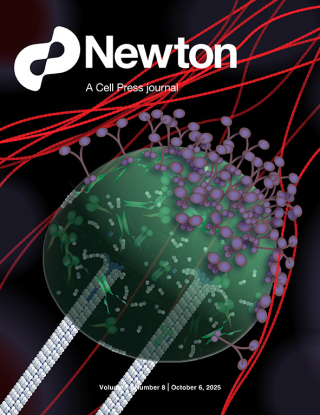-
20 Aug 2025 • Journal Article • Newton
A one-transistor organic electrochemical self-sustained oscillator model for neuromorphic networks
AbstractOrganic electrochemical transistors (OECTs) operating in wet biological environments offer new possibilities for neuromorphic biosensors and bioelectronics. This work presents a device physics approach to develop an organic spiking neuron using a single OECT combined with passive RC components. The key condition is that charge carrier mobility decreases with ion
… show more -
16 Jun 2025 • Journal Article • Advanced Intelligent Systems
Ultrathin (<10 nm) Electrochemical Random-Access Memory that Overcomes the Tradeoff between Robust Weight Update and Speed in Neuromorphic Systems
AbstractElectrochemical random-access memory (ECRAM) devices are a promising candidate for neuromorphic computing, as they mimic synaptic functions by modulating conductance through ion migration. However, the use of a thick electrolyte layer (>40 nm) in conventional ECRAMs leads to an unavoidable tradeoff between synaptic weight updates and operating speed. To address this
… show more -
1 Apr 2025 • Journal Article • Advanced Functional Materials
Transient Current Responses of Organic Electrochemical Transistors: Evaluating Ion Diffusion, Chemical Capacitance, and Series Elements
AbstractFor the successful implementation of organic electrochemical transistors in neuromorphic computing, bioelectronics, and real-time sensing applications it is essential to understand the factors that influence device switching times. This work describes a physical-electrochemical model of the transient response to a step of the gate voltage. The model incorporates 1) ion
… show more -
Mar 2025 • Journal Article • Advanced Electronic Materials
Magneto-Capacitance of PEDOT:PSS Thin Films; Effects of a Two-Phase System and Coulomb Interaction
AbstractThe study of the net magneto-capacitance, C(B), in thin films of the conducting polymer Poly(3 4-ethylenedioxythiophene):poly(styrene sulfonate) (PEDOT:PSS) is presented. In the films there are charged electrically-conducting PEDOT-rich regions surrounded by PSS insulating charged material. The high-conductivity grade PEDOT:PSS thin films are studied at low temperature
… show more -
10 Jan 2025 • Journal Article • Nature Electronics
Improved organic electrochemical transistor stability using solvent degassing and chemical doping
AbstractOrganic mixed ionic–electronic conductors (OMIECs), which can be used to build organic electrochemical transistors (OECTs), are of potential use in flexible, large-area and bioelectronic systems. Although hole-transporting p-type OMIECs are susceptible to oxidation, and oxygen leads to OECT instability, it is unclear whether oxygen also behaves as an uncontrolled p-dopant
… show more -
28 Sep 2024 • Journal Article • Journal of Applied Physics
Experimentally verified organic electrochemical transistor model
AbstractThe Bernards–Malliaras model, published in 2007, is the primary reference for the operation of organic electrochemical transistors (OECTs). It assumes that, as in most transistors, the electronic transport is drift only. However, in other electrochemical devices, such as batteries, the charge neutrality is accompanied by diffusion-only transport. Using detailed 2D device
… show more -
25 Jul 2024 • Journal Article • Advanced Science
Switching Response in Organic Electrochemical Transistors by Ionic Diffusion and Electronic Transport
AbstractThe switching response in organic electrochemical transistors (OECT) is a basic effect in which a transient current occurs in response to a voltage perturbation. This phenomenon has an important impact on different aspects of the application of OECT, such as the equilibration times, the hysteresis dependence on scan rates, and the synaptic properties for neuromorphic
… show more -
1 Jul 2024 • Journal Article • Advanced Materials
Electrical Doping of Metal Halide Perovskites by Co-evaporation and Application in PN Junctions
AbstractElectrical doping of semiconductors is a revolutionary development that enabled many electronic and optoelectronic technologies. While doping of many inorganic and organic semiconductors has been well-established, controlled electrical doping of metal halide perovskites is yet to be demonstrated. In this work, we achieve efficient n- and p-type electrical doping of
… show more -
1 Jun 2024 • Journal Article • Advanced Electronic Materials
Unveiling the Impact of the Electrolyte's Counter Ions on Organic Electrochemical Transistor Performance
AbstractThe effect of the electrolyte's counter-ion in organic electrochemical transistors is often neglected. the influence of anions (i.e., counter ions) is investigated on organic electrochemical transistors (OECTs) with a PEDOT:PSS-like semiconductor through device simulations. The study examined the effects of mobile anions on OECT performance under two scenarios: when
… show more -
29 Feb 2024 • Journal Article • Scientific Reports
Strategy to improve synaptic behavior of ion-actuated synaptic transistors—the use of ion blocking layer to improve state retention
AbstractSynaptic transistors (STs) with a gate/electrolyte/channel stack, where mobile ions are electrically driven across the solid electrolyte, have been considered as analog weight elements for neuromorphic computing. The current (ID) between the source and drain in the ST is analogously updated by gate voltage (VG) pulses, enabling high pattern recognition accuracy in
… show more










































